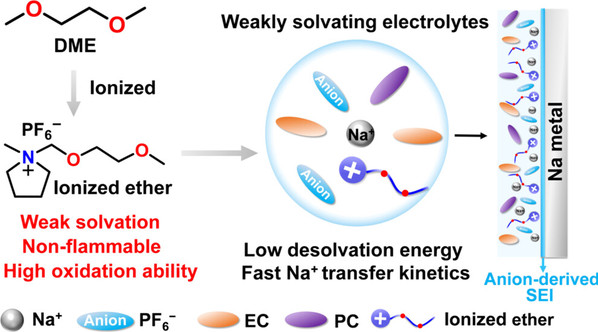Weakly Solvating Electrolytes for Safe and Fast-Charging Sodium Metal Batteries
Mingzhu Wu, Mingchen Yang, Jiangtao Yu, Xinyu Ma, Shipeng Sun, Yupo She, Jinhua Yang, Xiuyang Zou(邹修洋)*,Yin Hu(胡寅)*, Feng Yan(严锋)*
1Jiangsu Engineering Laboratory of Novel Functional Polymeric Materials, Jiangsu Key Laboratory of Advanced Negative Carbon Technologies College of Chemistry, Suzhou Key Laboratory of Soft Material and New Energy, College of Chemistry, Chemical Engineering and Materials Science, Soochow University, Suzhou 215123, China
2Jiangsu Engineering Research Center for Environmental Functional Materials, School of Chemistry and Chemical Engineering, Huaiyin Normal University, Huaian 223300, China
3State Key Laboratory for Modification of Chemical Fibers and Polymer Materials, College of Materials Science and Engineering, Donghua University, Shanghai 201620,China
J. Am. Chem. Soc. 2024, 146, 51, 35229–35241
Abstract: Electrolytes for high-performance sodium metal batteries (SMBs) are expected to have high electrode compatibility, low solvation energy, and nonflammability. However, conventional flammable carbonate ester electrolytes show high Na+ desolvation energy and poor compatibility with sodium metal anodes, leading to slow Faradaic reactions and significant degradation of SMBs. Herein, we report a weakly solvating electrolytes (WSEs) design developed by an ionized ether-induced solvent molecule polarization strategy. The steric hindrance and electron-withdrawing effect of the pyrrolidine cation weaken the solvation ability of the ionized ether and enable carbonate ester with low solvation energy through intermolecular polarization interactions. It enables WSEs with fast Na+ migration kinetics and electric-field-reinforced cationic electrode/electrolyte interface, thereby promoting the stability and reversibility of SMBs even under high-charge-rate conditions. The Na||Na3V2(PO4)3 battery with ionized ether-based WSEs exhibits a capacity retention of 83.5% with an average Coulombic efficiency (CE) of 99.69% after 500 cycles at 10C. Furthermore, the Na||Na2Fe2(SO4)3 cells maintained 92.8% capacity retention after 1000 cycles at 5C with an average CE of 99.77% at a cutoff voltage of 4.5 V. The ionized ether also eliminates the fire and safety risks associated with WSEs. This work offers valuable insights into the design of WSEs for safe and high-performance sodium metal batteries.

Article information: //doi.org/10.1021/jacs.4c12353